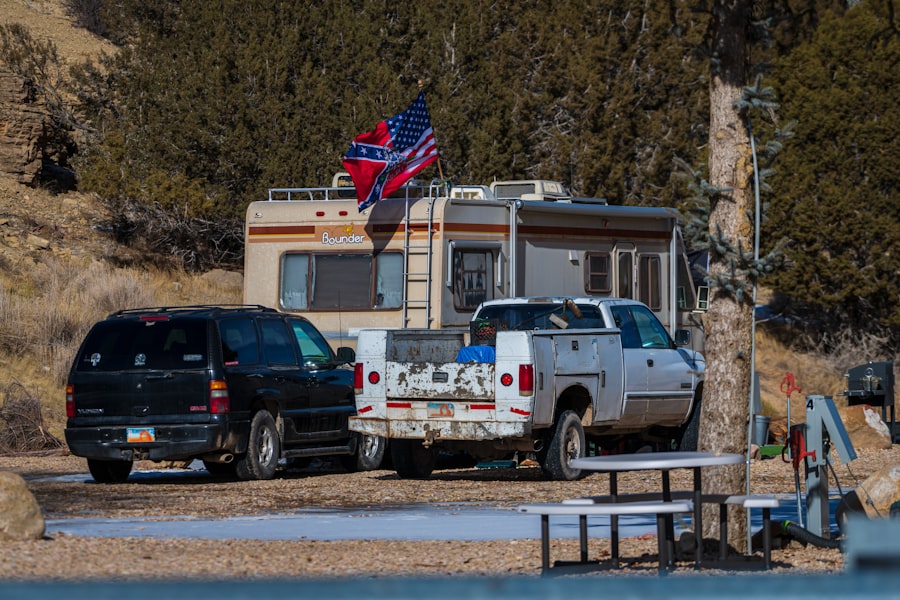When a disaster strikes, whether it be a natural calamity like a hurricane or an unforeseen event such as a terrorist attack, the authority of the U.S. government comes into play to manage the situation effectively. The federal government has established a framework that allows for a coordinated response to disasters, ensuring that resources are allocated efficiently and that affected communities receive the necessary support.
This authority is not arbitrary; it is rooted in legislation and policy designed to protect citizens and restore order in times of crisis. Understanding the government’s role in declared disasters is crucial for citizens, as it shapes how aid is delivered and how recovery efforts are organized. The interplay between federal, state, and local authorities creates a complex web of responsibilities and actions that can significantly impact the speed and effectiveness of disaster response.
As you delve deeper into this topic, you will uncover the mechanisms that enable the government to act swiftly and decisively when disaster strikes.
Key Takeaways
- The US government has the authority to declare disasters and coordinate response efforts.
- The President plays a key role in declaring a disaster and activating federal resources.
- FEMA is responsible for coordinating disaster response and providing assistance to affected areas.
- The Stafford Act outlines the federal government’s role in disaster response and recovery.
- The National Response Framework ensures coordination among federal agencies in disaster response.
The Role of the President in Declaring a Disaster
The President of the United States plays a pivotal role in the disaster declaration process. When a disaster overwhelms state and local resources, the President has the authority to issue a disaster declaration, which unlocks federal assistance for recovery efforts. This declaration is not made lightly; it requires a thorough assessment of the situation and often involves consultations with state governors and emergency management officials.
By declaring a disaster, the President signals that the federal government is prepared to step in and provide support where it is most needed. Once a disaster is declared, the President’s role extends beyond just issuing a statement. You will find that the President often mobilizes federal resources, coordinates with various agencies, and communicates with the public to ensure that information flows smoothly.
This leadership is essential in fostering trust and confidence among citizens who may be feeling vulnerable during such trying times. The President’s actions can set the tone for the entire response effort, influencing how quickly aid reaches those affected.
The Federal Emergency Management Agency (FEMA) and Its Responsibilities

The Federal Emergency Management Agency (FEMA) is at the forefront of disaster response in the United States. Established to coordinate the federal government’s response to disasters, FEMA plays a critical role in managing resources, providing assistance, and facilitating recovery efforts. When a disaster is declared, FEMA springs into action, working closely with state and local governments to assess needs and deploy resources effectively.
You may be surprised to learn that FEMA’s responsibilities extend beyond immediate response; they also encompass long-term recovery planning and mitigation efforts.
As you explore FEMA’s role further, you will discover how they collaborate with various stakeholders, including non-profit organizations and private sector partners, to enhance their response capabilities.
This collaboration is vital for ensuring that aid reaches those who need it most and that recovery efforts are sustainable in the long run.
The Stafford Act and Its Implications for Disaster Response
| Aspect | Details |
|---|---|
| Enacted | 1974 |
| Authority | Federal Emergency Management Agency (FEMA) |
| Scope | Response and recovery for natural and man-made disasters |
| Assistance | Financial and logistical support to state and local governments |
| Declaration | Presidential disaster declaration required for federal assistance |
| Amendments | Several amendments to expand and refine the Act |
The Stafford Act serves as the cornerstone of federal disaster response policy in the United States. Enacted in 1988, this legislation outlines the process for federal assistance during major disasters and emergencies. Under the Stafford Act, states must request federal aid when they are unable to manage a disaster on their own.
This legal framework establishes clear guidelines for how federal resources can be deployed, ensuring that assistance is provided in an organized manner. As you delve into the implications of the Stafford Act, you will find that it not only facilitates immediate relief but also sets the stage for long-term recovery efforts. The Act allows for various forms of assistance, including public assistance for infrastructure repair and individual assistance for those affected by disasters.
Understanding this legislation is crucial for grasping how federal authority operates during declared disasters and how it impacts communities across the nation.
The National Response Framework and the Coordination of Federal Agencies
The National Response Framework (NRF) is another essential component of the U.S. government’s disaster response strategy. This framework outlines how federal agencies coordinate their efforts during a disaster, ensuring that resources are utilized efficiently and effectively.
The NRF emphasizes a whole-community approach, recognizing that successful disaster response requires collaboration among federal, state, local, tribal, and private sector partners. As you explore the NRF further, you will see how it establishes clear roles and responsibilities for various agencies involved in disaster response. This coordination is vital for minimizing confusion and maximizing resource allocation during emergencies.
The NRF also emphasizes preparedness and resilience, encouraging communities to develop their own plans and capabilities to respond to disasters before they occur.
The Role of State and Local Governments in Disaster Response

While federal agencies play a significant role in disaster response, state and local governments are often on the front lines when disasters strike. These entities are typically the first responders, tasked with managing immediate needs such as search and rescue operations, medical assistance, and sheltering displaced individuals.
State governments also play a critical role in coordinating with federal agencies like FEMA when requesting assistance. They assess damage, determine needs, and communicate with federal officials to ensure that help arrives promptly. Local governments often have established emergency management plans tailored to their specific communities, allowing them to respond quickly and efficiently when disaster strikes.
This grassroots approach is essential for effective disaster management.
The Importance of Interagency Cooperation in Declared Disasters
Interagency cooperation is vital during declared disasters, as multiple agencies must work together to provide comprehensive support to affected communities. This collaboration ensures that resources are shared effectively and that all aspects of disaster response are addressed. You may find it interesting that this cooperation extends beyond just government agencies; non-profit organizations, private sector partners, and community groups also play crucial roles in supporting recovery efforts.
The success of interagency cooperation hinges on clear communication and established protocols. When agencies understand their roles and responsibilities within the larger framework of disaster response, they can work more efficiently together. This cooperation not only enhances immediate response efforts but also contributes to long-term recovery by fostering relationships among various stakeholders who can continue to support communities after the initial crisis has passed.
The Use of Federal Funds in Disaster Recovery Efforts
Federal funds play a critical role in disaster recovery efforts across the United States. When a disaster is declared, financial resources become available through various programs administered by FEMA and other federal agencies. These funds can be used for immediate relief efforts such as providing food, shelter, and medical care to those affected by disasters.
Additionally, they support long-term recovery initiatives aimed at rebuilding infrastructure and restoring services. As you consider the implications of federal funding in disaster recovery, it’s essential to recognize that these resources are often contingent upon specific criteria outlined in legislation like the Stafford Act. This means that states must demonstrate their need for assistance and adhere to guidelines for how funds can be used.
Understanding this process can help you appreciate both the opportunities and challenges associated with federal funding during times of crisis.
The Legal Framework for Federal Authority in Declared Disasters
The legal framework governing federal authority in declared disasters is complex but essential for understanding how aid is delivered during emergencies. Various laws and regulations outline the powers granted to federal agencies and officials when responding to disasters. These legal provisions ensure that actions taken during emergencies are consistent with constitutional principles while providing necessary flexibility to address urgent needs.
You will find that this legal framework includes not only the Stafford Act but also other legislation such as the National Emergencies Act and various executive orders issued by Presidents over time. Together, these laws create a comprehensive system that empowers federal authorities to act decisively while also holding them accountable for their actions during disasters.
The Limits of Federal Authority in Declared Disasters
While federal authority plays a crucial role in disaster response, it is not without its limits. The U.S. Constitution grants states significant powers regarding emergency management, meaning that federal intervention must be carefully balanced with respect for state sovereignty.
You may find it intriguing that this balance can sometimes lead to tensions between state and federal authorities during disasters. Additionally, there are practical limitations on federal resources that can impact response efforts. While federal agencies like FEMA have substantial capabilities, they cannot address every need or concern arising from a disaster.
Understanding these limitations helps clarify why collaboration between federal, state, and local governments is so essential; no single entity can manage all aspects of disaster response alone.
The Future of Disaster Response and Federal Authority in the US
As climate change continues to influence weather patterns and increase the frequency of natural disasters, the future of disaster response in the U.S. will likely evolve significantly. You may wonder how federal authority will adapt to meet these challenges while ensuring effective coordination among various levels of government.
Innovations in technology, data analysis, and communication will play critical roles in shaping future responses. Moreover, there is an increasing emphasis on community resilience and preparedness at all levels of government. As you consider what lies ahead for disaster response in America, think about how fostering local capabilities can enhance overall effectiveness when disasters occur.
By empowering communities to take proactive measures while maintaining strong partnerships with federal authorities, we can create a more resilient nation capable of facing future challenges head-on. In conclusion, understanding the U.S. government’s authority in declared disasters reveals a complex interplay between various levels of government and agencies working together toward a common goal: protecting citizens during times of crisis.
As you reflect on this topic, consider how each component contributes to an effective disaster response system that ultimately aims to save lives and restore communities after devastating events.
In times of declared disasters, the U.S. government often exercises expanded powers to ensure public safety and manage resources effectively. This can include measures such as deploying the National Guard, implementing curfews, and coordinating with state and local agencies to streamline response efforts. An insightful article discussing the scope and implications of these powers can be found on Real Lore and Order. For a deeper understanding of how these powers are enacted and their impact on civil liberties, you can read more about it here. This article provides a comprehensive overview of the legal frameworks and historical precedents that guide governmental actions during such critical times.
WATCH THIS! The 8 Assets You OWN But the Government CONTROLS (Dollar Collapse Survival)
FAQs
What is the US government’s power during a declared disaster?
The US government has the power to declare a state of emergency or disaster, which grants it the authority to take certain actions to address the situation.
What actions can the US government take during a declared disaster?
During a declared disaster, the US government can mobilize resources, provide financial assistance, and coordinate response efforts across federal, state, and local agencies.
Can the US government restrict certain activities during a declared disaster?
Yes, the US government can impose restrictions on certain activities, such as travel, commerce, and public gatherings, in order to protect public safety and mitigate the impact of the disaster.
What role does the Federal Emergency Management Agency (FEMA) play during a declared disaster?
FEMA is responsible for coordinating the federal government’s response to disasters and providing assistance to affected individuals, communities, and governments.
How long can a state of emergency or disaster declaration last?
The duration of a state of emergency or disaster declaration varies depending on the specific circumstances and the actions needed to address the situation. It can be lifted once the situation is deemed to be under control.
